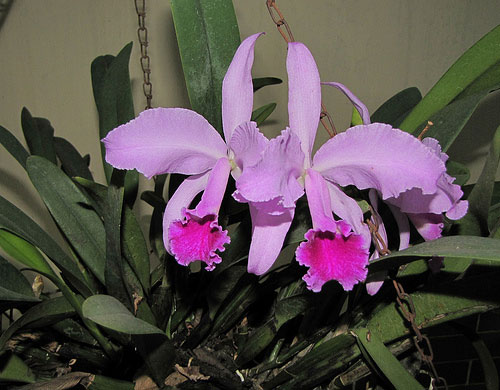Cattleya Orchid
Cattleya orchids have long been popular. They are common cut flowers, but I prefer them still on the plant! Some Cattleyas have few, large flowers, others will make several smaller flowers per inflorescence. There are also a number of other orchid types related to Cattleyas, such as Laelia, and Brassavola. Sophronitis has been recently reclassified into the Cattleya genus. There are also many intergeneric hybrids whose parentage involves two or more genera from the Cattleya alliance. Many Cattleyas can bloom 2-3 times per year, though once per year is more common. A few species are fragrant.

C. labiata
These plants originate in Central and South America. They grow as epiphytes, often in habitats that are somewhat dry for part of the year. They typically grow in places that are exposed to quite strong light, and the roots are usually exposed so that they dry out quickly after each time it rains.
The plants are sympodial, meaning they produce a series of growths from a horizontal rhizome. Each growth has a pseudobulb, covered in a thin, papery layer made from a dead leaf (called a bract). The pseudobulbs are thick, but significantly longer than they are wide. At the top of the pseudobulb, some species (the unifoliate group) produce a single leaf, while others have two leaves (or occasionally three). The leaves are thickened somewhat to help the plant conserve moisture. Also at the top of the pseudobulb there is small sheath that protects the developing inflorescence before it extends and blooms. (You can see when the buds start to develop: put some backlight on the sheath, and you'll see a shadow when the plant starts preparing to bloom.)
The first species to be discovered was C. labiata (pictured above); a man named William Cattley received one in a shipment of orchids, used as packing material for other plants! He nursed it back to health, and when it bloomed the botanist John Lindley named the genus after him. The plant created great excitement at the time!
Cattleyas are easy to grow. Here's what you need to know:
Provide high lighting, 2000-3000 footcandles, such as a south-facing window or a bright east-facing window. (In the northern hemisphere, anyway!) Direct sunlight will usually be too much, though you may be able to acclimate plants to it. If the plant doesn't bloom, the first thing to try is giving it more light.
Cattleyas like to dry out briefly between waterings; use a potting mix such as medium-grade fir bark that drains well. (Repot when the plant starts growing over the edge of the pot.) After flowering, some species like a short dry rest: water a bit less for the next couple of months, then resume normal watering and fertilizing.
Most do best at intermediate temperatures, typically 70-80°F (21-27C) during the day with a 10-15°F drop in temperatures at night (6-8C). Some species need it warmer than this, but intermediate temperatures are best for most. (If there's enough light and your plant isn't doing well, try increasing the temperature.) Many Cattleyas come from somewhat more arid areas than most tropical orchids, so they can do well with a bit less humidity, say 50-60%.
Let's See YOUR Cattleya Orchids!
Brag about your favorite Cattleya orchids! Upload pictures and say how you grew them so well, or congratulate others on their plants in the comments section!
Othere Visitors' Plants
Click the links below to see other people's favorite Cattleyas!
Return from Cattleya Orchid to Types of Orchids
Return from Cattleya Orchid to Orchid Care Tips Home





